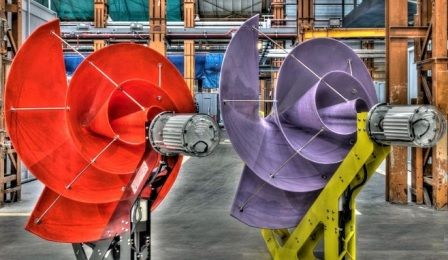Categories: Featured Articles » Interesting electrical news
Number of views: 57084
Comments on the article: 3
5 unusual designs of wind generators
 Wind energy is actively developing around the world, and it is no secret to anyone that this is one of the most promising areas of alternative energy at the moment. By mid-2014, the total capacity of all installed wind generators in the world was 336 gigawatts, and the largest and most powerful vertical three-bladed Vestas-164 wind generator was installed and launched in early 2014 in Denmark. Its power reaches 8 megawatts, and the span of the blades is 164 meters.
Wind energy is actively developing around the world, and it is no secret to anyone that this is one of the most promising areas of alternative energy at the moment. By mid-2014, the total capacity of all installed wind generators in the world was 336 gigawatts, and the largest and most powerful vertical three-bladed Vestas-164 wind generator was installed and launched in early 2014 in Denmark. Its power reaches 8 megawatts, and the span of the blades is 164 meters.
Despite the long-running technology of manufacturing vane turbines and windmills in general, many enthusiasts seek to improve the technology, increase its efficiency and reduce negative factors.
As is known, the coefficient of utilization of the energy of the wind flow traditional wind generators at best, it reaches 30%, they are quite noisy and upset the natural heat balance of the surrounding territories, increasing the temperature of the surface air layer at night. They are also very dangerous for birds and occupy large areas.
What alternatives exist? In fact, the work of modern inventors knows no bounds, and many different alternatives have been invented.
Let's look at the 5 most unusual of the industry’s most noteworthy alternative designs for wind turbines.
Since 2010, the American company Altaeros Energies, based at the Massachusetts Research Institute, has been developing a new generation of wind generators. A new type of wind generator is designed to operate at heights of up to 600 meters, where ordinary wind generators simply can not get. It is at such high altitudes that the strongest winds constantly blow, which are 5-8 times stronger than winds near the surface of the earth.

The generator is an inflatable structure, similar to a helium-inflated airship, in which a three-blade turbine is installed on the horizontal axis. Such a wind generator was launched in 2014 in Alaska to a height of about 300 meters for testing for 18 months.

The developers claim that this technology will allow to receive electricity worth 18 cents per kilowatt hour, which is half the usual cost of wind electricity in Alaska. In the future, such generators may well be able to replace diesel power plants, as well as find application in problem areas.
In the future, this device will not only be an electric power generator, but also part of a weather station and a convenient means of providing the Internet in territories far from the corresponding infrastructure.
After installation, such a system does not require the presence of personnel, does not occupy a large area, and is almost silent. It can be controlled remotely, and requires maintenance only once every 1-1.5 years.

Another interesting decision to create an unusual design of a wind farm is being implemented in the United Arab Emirates. Not far from Abu Dhabi, the city of Madsar is being built, in which they plan to build a rather unusual wind farm, called by the developers of "Windstalk".
The founder of Atelier DNA, a New York-based design company developing the design for this project, said that the main idea was to find a kinetic model in nature that could serve to generate electricity, and such a model was found. 1203 stems of carbon fiber, each about 55 meters high, with concrete bases 20 meters wide, will be installed 10 meters apart.
The stems will be reinforced with rubber, and have a width of about 30 cm at the base, and taper up to 5 centimeters at the top.Each such stem will contain alternating layers of electrodes and ceramic disks made from a piezoelectric material that generates an electric current when it is subjected to pressure.
When the stems will swing in the wind, the discs will shrink, generating electric current. No noise from the blades of wind turbines, no victims among the birds, nothing but the wind.
The idea came about by observing the reeds swaying in the swamp.
Atelier DNA’s Windstalk project won runner-up in the Land Art Generator competition sponsored by Madsar to select the best international artwork to generate energy from renewable sources.
The area occupied by this unusual wind station will cover 2.6 hectares, and in terms of power it will correspond to a conventional wind generator, occupying a similar area. The system is effective due to the absence of friction losses inherent in traditional mechanical systems.
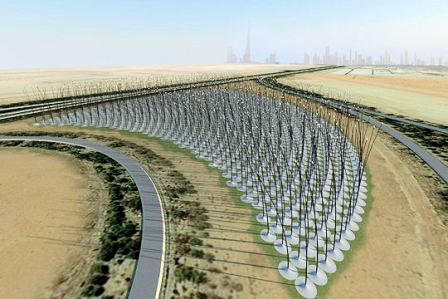
At the base of each stem will be a generator that converts torque from the stem using a shock absorber and cylinder system, similar to the Levant Power system developed in Cambridge, Massachusetts.
Since the wind is not constant, an energy storage system will be applied so that the accumulated energy can be spent even when there is no wind, explain the employees working on the project.
At the top of each stalk, an LED light will be installed, the brightness of which will directly depend on the strength of the wind and the amount of electricity currently generated.
Windstalk will work on a chaotic wiggle, which allows you to place the elements much more closer to each other than is possible with conventional blade-type wind turbines.
A similar Wavestalk project is being developed to convert the energy of ocean currents and waves, where a similar system will be upside down under water.
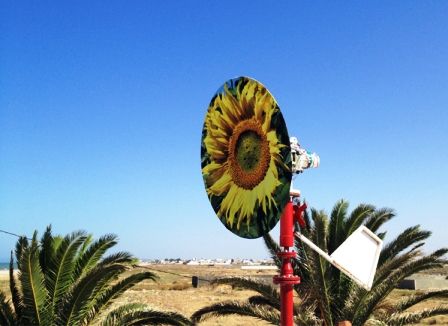
The project, developed by Saphon Energy from Tunisia, as well as Windstalk, is a bladeless wind generator, but this time the device has a sail-type design.
This silent generator, resembling a satellite dish in shape, was called Saphonian. It has no rotating parts and is completely safe for birds. The generator screen makes movement back and forth, creating vibrations in the hydraulic system.
The goal of the project is to improve the performance of wind generators regarding the use of wind flow. The wind literally harnesses into a sail, which makes forward and backward movements under its action, while there are no blades, no rotor, no gears. This interaction allows you to convert more kinetic energy into mechanical energy using pistons.
Energy can be accumulated in hydraulic accumulators, or converted into electrical energy by means of a generator, or some mechanism can be used to rotate it. If ordinary wind generators have an efficiency of 30%, then this sailing type generator gives all 80%. Its efficiency exceeds blades type windmills 2.3 times.

Due to the lack of expensive components, as is the case in a wind turbine (blades, hubs, gearboxes), in the case of Saphonian, equipment costs are reduced to 45%.
The aerodynamic shape of the Saphonian has the advantage that turbulent wind currents have little effect on the body of the sail, and the aerodynamic force only increases. It is because of turbulence that wind turbines are not used in urban areas, and Saphonian can also be used there. In addition, harmful acoustic and vibration factors are minimized. Saphon Energy has been awarded the KPMG Award for Innovation.
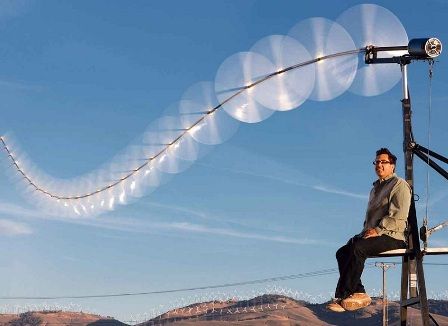
Another very revolutionary approach to the use of wind energy was implemented in 2008 by an inventor - an enthusiast from California.Large wind generators for small towns are the size of a 30-story building, and their blades reach the size of the wings of a Boeing 747.
These giant generators certainly produce a lot of energy, but the production, transportation, and installation of such systems are complex and expensive. Despite this, the industry is growing by more than 40 percent every year. That's what Dag Selsam of California thought about before setting his ambitious goal. He decided that it was realistic to get more energy using less materials.
By installing a dozen or several dozen small rotors on one shaft connected to one generator, Doug, in the end, achieved his goal. He connected one end of the long shaft to the generator, and launched the other end into the heights on balloons with helium. The system worked as expected.
In the textbooks, Doug read that a single-rotor turbine is enough to get the maximum, but Doug has doubts. He thought otherwise: the more rotors, the more wind energy is available for use.
If each rotor is located at the right angle, then each rotor will receive its own wind, and this will increase the generation efficiency.
Of course, this complicates the physics, because now it was necessary to make sure that each rotor catches its own stream, and not just the stream from the nearby rotor. It was necessary to find out the optimal angle for the shaft in relation to the wind and the ideal distance between the rotors. And, in the end, the gain was obtained using less material.
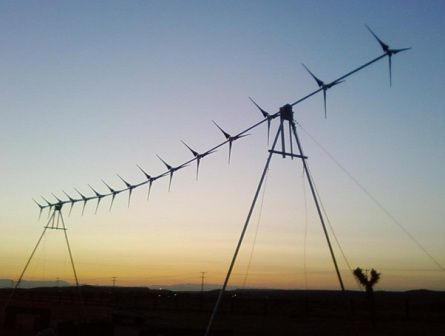
In 2003, the inventor received a $ 75,000 grant from the California Energy Commission to develop a 3,000-watt turbine with seven rotors. The task was successfully solved, and Dag Selsam has already sold more than 20 of its 2000-watt double-rotor turbines to several homeowners. He built these devices in his country garage.
Doug's idea was one of the few ideas that actually have every chance of achieving great success in the commercial world. Selsam says two rotors are just the beginning. He will probably someday see his multi-rotor mile-long turbines across the sky.
"We can go further and make much more powerful turbines using this technology, it will surpass the wildest fantasies of General Electric," says the inventor.
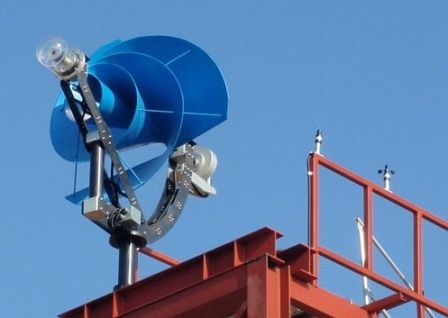
Archimedes, based in Rotterdam, the Netherlands, has come up with its own concept of unusual wind turbines that can be installed directly on the roofs of residential buildings.
According to the authors of the project, an effective low-noise design can provide a small house with electricity, and a complex of such generators, working in conjunction with standard solar panels, able to completely reduce to zero the dependence of a large building on external sources of electricity. New wind turbines are called Liam F1.
A small turbine with a diameter of 1.5 meters and weighing about 100 kilograms can be installed on any wall or roof of a residential building. Typically, the height of terraced roofs is 10 meters, and the wind in the country is almost always South-West. These conditions are enough to properly place the turbine on the roof, and effectively use wind energy.
Two problems of conventional wind generators are solved here: the noise of conventional blade turbines and the high cost of installing bulky equipment. In conventional wind generators, installation costs often do not pay off. The noise level of the Liam turbine is about 45dB, and this is even quieter than the noise of rain (rain noise in the forest is 50dB).
In shape resembling a shell of a snail, the turbine, like a weather vane, turns in the wind, capturing the air flow, reducing its speed, and changing direction. Director of the company Marinus Miremeta claims that the efficiency of an innovative turbine reaches 80% of the maximum efficiency theoretically available in wind energy. And this is already quite enough.
In the Netherlands, the average family consumes 3300 kWh of electricity per year.According to the developers, half of this energy can be provided by one Liam F1 turbine at a wind speed of at least 4.5 m / s.
Three such turbines can be placed at the vertices of the triangle on the roof of the house, then each of the turbines will be provided with wind and they will not interfere with each other, but on the contrary will help each other.
If we are talking about installing in a city where there are turbulent flows, the manufacturer suggests slightly raising the wind generators installed on city roofs, attaching them to poles so that the walls of neighboring houses do not interfere with wind flows.
The estimated cost of the new turbine with the installation is 3999 euros. Since the device has a size of more than one meter, a special license for its use may be required, therefore, in the most extreme case, the company also produces mini-Liam turbines with a diameter of 0.75 meters.
Manufacturers plan to use their turbines not only for power supply of residential and industrial buildings, but also for power supply of marine vessels.
As you can see, there are plenty of interesting alternatives from manufacturers of wind generators.
See also at bgv.electricianexp.com
:

